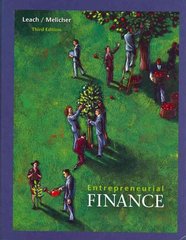Question
Cascade Water Company (CWC) currently has 30,000,000 shares of common stock outstanding that trade at a price of $42 per share. CWC also has 500,000
Cascade Water Company (CWC) currently has 30,000,000 shares of common stock outstanding that trade at a price of $42 per share. CWC also has 500,000 bonds outstanding that currently trade at $923.38 each. CWC has no preferred stock outstanding and has an equity beta of 2.639. The risk-free rate is 3.5%, and the market is expected to return 12.52%. The firm's bonds have a 20-year life, a $1,000 par value, a 10% coupon rate, and pay interest semiannually. CWC is considering adding to its product mix a healthy bottled water geared toward children. The initial outlay for the project is expected to be $3,000,000, which will be depreciated using the straight-line method to a zero salvage value, and sales are expected to be 1,250,000 units per year at a price of $1.25 per unit. Variable costs are estimated to be $0.24 per unit, and fixed costs of the project are estimated at $200,000 per year. The project is expected to have a 3-year life and a terminal value (excluding the operating cash flows in year 3) of $500,000. CWC has a 34% tax rate. For the purposes of this project, working capital effects will be ignored. Bottled water targeted at children is expected to have different risk characteristics from the firm's current products. Therefore, CWC has decided to use the "pure play" approach to evaluate this project. After researching the market, CWC managed to find two pure-play firms. The specifics for those two firms are:
Firm Equity Beta D/E Tax Rate
Fruity Water 1.72 0.43 34%
Ladybug Drinks 1.84 0.35 36%
Question:
Should the firm undertake the healthy bottled water project? Why or why not? As part of your analysis, include a sensitivity analysis for sales price, variable costs, fixed costs, and unit sales at +/- 10%, 20%, and 30% from the base case. Also, perform an analysis of the following two scenarios:
a. Best case: Selling 2,5000,000 units at a price of $1.24 per unit, with variable production costs of $0.22 per unit.
B. Worst case: Selling 950,000 units at a price of $1.32 per unit, with variable production costs of $0.27 per unit.
Step by Step Solution
There are 3 Steps involved in it
Step: 1

Get Instant Access to Expert-Tailored Solutions
See step-by-step solutions with expert insights and AI powered tools for academic success
Step: 2

Step: 3

Ace Your Homework with AI
Get the answers you need in no time with our AI-driven, step-by-step assistance
Get Started


